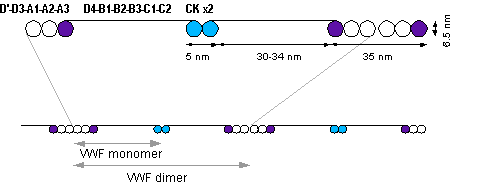Von Willebrand factor
|
|
Von Willebrand factor (vWF, also called "Factor VIII-related antigen") is a blood protein of the coagulation system. It is defective in von Willebrand disease and is involved in a large number of other diseases, including thrombotic thrombocytopenic purpura, Heyde's syndrome, and possibly hemolytic-uremic syndrome.
| Contents |
Biochemistry
Synthesis
vWF is a large multimeric glycoprotein present in blood plasma and produced constitutively in endothelium (in the Weibel-Palade bodies), megakaryocytes (α-granules of platelets), and subendothelial connective tissue.
Structure
The basic vWF monomer is a 2050 amino acid protein. Every monomer contains a number of specific domains with a specific function; elements of note are:- the D'/D3 domain, which binds to Factor VIII
- the A1 domain, which binds to:
- the A3 domain, which binds to collagen
- the C1 domain, in which the RGD domain binds to platelet integrin αIIbβ3 when this is activated
- the "cysteine knot" domain (at the C-terminal end of the protein), which vWF shares with platelet-derived growth factor (PDGF), transforming growth factor-β (TGFβ) and β-human chorionic gonadotrophin (βHCG, of pregnancy test fame).
Monomers are subsequently N-glycosylated, arranged into dimers in the endoplasmic reticulum and into multimers in the Golgi apparatus by crosslinking of cysteine residues via disulfide bonds. With respect to the glycosylation, vWF is one of the few proteins that carry blood group antigens (ABO system).
Multimers of vWF can be extremely large, >20,000 kDa, and consist of over 80 subunits of 250 kDa each. Only the large multimers are functional. Some cleavage products that result from vWF production are also secreted but probably serve no function.
Function
Von Willebrand factor is not an enzyme and therefore has no catalytic activity. Its main function is binding to other proteins, mainly in the process of coagulation.
As stated above, vWF binds to a number of cells and molecules. The most important ones are:
- Factor VIII is bound to vWF in the circulation; it is degraded rapidly in the absence of this relationship. For this reason, vWF is also called factor VIII-related antigen.
- vWF binds to collagen, e.g., when it is exposed in endothelial damage.
- vWF binds to platelet gpIb when it forms a complex with gpIX and gpV; this binding occurs under all circumstances, but is most efficient under high shear stress (i.e., rapid blood flow in narrow blood vessels, see below).
- vWF binds to other platelet receptors when they are activated, e.g., by thrombin (i.e., when coagulation has been stimulated).
vWF appears to play a major role in circumstances of high shear stress, and vWF deficiency (von Willebrand disease) therefore leads to a tendency to bleed, which is most apparent in tissues having high blood flow in narrow vessels. From studies it appears that vWF uncoils under these circumstances, decelerating passing platelets.
Catabolism
The biological breakdown (catabolism) of vWF is largely mediated by a protein cryptically termed ADAMTS13 (acronym of "a disintegrin-like and metalloprotease with thrombospondin type 1 motif no. 13"). It is a metalloproteinase which cleaves vWF between tyrosine at position 842 and methionine at position 843. This breaks down the multimers into smaller units, which are degraded by other peptidases.
Role in disease
- Hereditary defects of vWF lead to von Willebrand disease (vWD), a bleeding diathesis of the skin and mucous membranes, causing nosebleeds, menorrhagia, and gastrointestinal bleeding. The point at which the mutation occurs determines the severity of the bleeding diathesis.
- Some diseases affect the structure of vWF and lead to acquired vWD. Recently, Heyde's syndrome (bleeding from angiodysplasia in the colon in association with aortic valve stenosis) was shown to be due to breakdown of vWF high-molecular weight multimers.
- In thrombotic thrombocytopenic purpura (TTP), ADAMTS13 is either deficient or has been inactivated by antibodies. This leads to decreased breakdown of vWF and microangiopathic hemolytic anemia with severe vascular symptoms.
History
vWF is named after Dr. Erik von Willebrand, a Finnish doctor who in 1924 first described a hereditary bleeding disorder in families from the Åland islands who had a tendency for cutaneous and mucosal bleeding, including menorrhagia. Although von Willebrand could not identify the definite cause, he distinguished von Willebrand disease (vWD) from hemophilia and other forms of bleeding diathesis.
In the 1950s, vWD was shown to be caused by a plasma factor deficiency (instead of being caused by platelet disorders), and in the 1970s, the vWF protein was purified.
Sources
- Sadler, J. E. Biochemistry and Genetics of von Willebrand factor. Annu Rev Biochem 1998; 67: 395-424. PMID 9759493.

